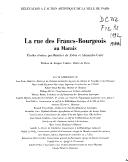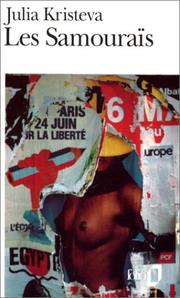| Listing 1 - 10 of 87 | << page >> |
Sort by
|
Book
ISBN: 0316888923 0821219626 9780316888929 9780821219621 Year: 1992 Publisher: Boston Little, Brown
Abstract | Keywords | Export | Availability | Bookmark
 Loading...
Loading...Choose an application
- Reference Manager
- EndNote
- RefWorks (Direct export to RefWorks)
"Paris: The City and Its Photographers looks for the first time at the history of photography and the part that Paris played in its development. The book is divided into four sections, the first of which follows the early years of photography when, after the announcement of Daguerre's momentous invention in 1839, increasing numbers of photographers could be seen carrying their cumbersome equipment around the city's streets. They documented medieval Old Paris, with its dark, winding alleyways; then, following the grand-scale demolition and rebuilding instigated by Napoleon III, they were the first to record the broad, tree-lined boulevards and fashionable cafes that are so familiar today. The second section begins in 1889 when, with the advent of the hand-held Kodak camera, photography became the province of the amateur as well as the professional. Over the next thirty years, snapshots of an ever more elegant Paris were placed in the family album alongside pictures of the latest wedd ing or christening. This was also the time, though, of Bohemian cafe society and of Atget, who, with tripod and black cape, spent the greater part of his life documenting the city. The third part describes how, after the First World War, photography needed new impetus, which it found with the arrival in Paris of Duchamp and the Dadaists, and the growth of Surrealism with Man Ray. In addition, photographers such as Kertesz, Brassai, Ilse Bing, and Lee Miller came to Paris to work, pushing the medium to its limits. The final section includes the founding of the Magnum Agency and the influence of Capa, Cartier-Bresson, and humanist photography. These are the years, too, of the Paris populaire of Doisneau, Izis, and Boubat; the Seine and its lovers, the cafes and fun-fairs... .It is the period, finally, of the last of the old Paris, and with the demonstrations of 1968 comes the end of an era. The photographs have been carefully chosen to encapsulate the style of their period. Each picture^ provides a unique record of the history of Paris; as a collection they evoke a Paris of decades past and are a lasting reminder of the artistry of their creators."--Jacket flap.
Photography --- History --- Paris (France) --- Pictorial works.
Book
Year: 1992 Publisher: Paris : Paris : Paris : B.N. (Bibliothèque Nationale), Musées et monuments de France, Albin Michel,
Abstract | Keywords | Export | Availability | Bookmark
 Loading...
Loading...Choose an application
- Reference Manager
- EndNote
- RefWorks (Direct export to RefWorks)
Book
Year: 1992 Publisher: Paris : Technorama,
Abstract | Keywords | Export | Availability | Bookmark
 Loading...
Loading...Choose an application
- Reference Manager
- EndNote
- RefWorks (Direct export to RefWorks)

ISBN: 9782905118431 2905118431 Year: 1992 Publisher: [Paris] : Délégation à l'action artistique de la ville de Paris,
Abstract | Keywords | Export | Availability | Bookmark
 Loading...
Loading...Choose an application
- Reference Manager
- EndNote
- RefWorks (Direct export to RefWorks)
Rue des Francs-Bourgeois (Paris, France) --- Paris (France) --- History. --- Buildings, structures, etc. --- Constructions
Book
Year: 1992 Publisher: [Paris]: La Mairie,
Abstract | Keywords | Export | Availability | Bookmark
 Loading...
Loading...Choose an application
- Reference Manager
- EndNote
- RefWorks (Direct export to RefWorks)
Martyres Parisienses anno 1792 --- Massacres --- France --- Paris (France)
Book
ISBN: 9782862603766 2862603767 Year: 1992 Publisher: Paris: Autrement,
Abstract | Keywords | Export | Availability | Bookmark
 Loading...
Loading...Choose an application
- Reference Manager
- EndNote
- RefWorks (Direct export to RefWorks)
A la découverte de ce quartier des affaires, aux portes de Paris, les polémiques qu'il a suscité et qu'il suscite toujours, son architecture, ses employés et ses habitants se croisant sans se rencontrer.
Zone industrielle --- Quartier --- Paris (France) --- La défense (paris)
Book
ISBN: 392150385X Year: 1992 Publisher: Nordlingen : Dr. Alfons Uhl,
Abstract | Keywords | Export | Availability | Bookmark
 Loading...
Loading...Choose an application
- Reference Manager
- EndNote
- RefWorks (Direct export to RefWorks)
Architecture domestique --- Jardins --- Dessins et plans --- Architecture --- Paris (France) --- Constructions
Film
Year: 1992 Publisher: [Lieu de publication inconnu]: Centre national de cinématographie,
Abstract | Keywords | Export | Availability | Bookmark
 Loading...
Loading...Choose an application
- Reference Manager
- EndNote
- RefWorks (Direct export to RefWorks)
Sur le flanc de Ménilmontant à Paris, la rue Vilin partait de la rue des Couronnes et, traçant sur 43 mètres une sorte de S inversé, débouchait sur la rue Piat par un escalier abrupt au sommet duquel on découvrait le plus beau panorama de la ville. C'est l'un des douze lieux parisiens dont Georges Perec avait, en 1969, projeté de décrire, douze ans durant, le devenir. La rue Vilin n'est plus. A son emplacement se trouve désormais un vaste espace vert. Classée en 1863, elle avait, environ un siècle plus tard, été déclarée îlot insalubre. Et le 4 mars 1982, le lendemain même de la mort de Perec, la pioche des démolisseurs achevait de la rayer de la carte, abattant notamment le n°24 où l'écrivain avait passé les six premières années de sa vie et où sa mère, déportée à Auschwitz en 1942, tenait un salon de coiffure. En remontant la rue Vilin à l'aide de quelques 500 photographies prises sur des décennies, en la reliant à l'oeuvre et à la biographie de Perec, Bober tente mimétiquement de dégager l'un des ressorts de sa démarche littéraire : nommer pour sauver de l'oubli, écrire pour témoigner de ce qui fut, "arracher quelques bribes précieuses au vide qui se creuse".
Photographie --- Rue --- Insalubrité --- Démolition --- Rénovation urbaine --- Paris (France) --- Ménilmontant

ISBN: 2070384721 9782070384723 Year: 1992 Volume: 2351 Publisher: Paris: Gallimard,
Abstract | Keywords | Export | Availability | Bookmark
 Loading...
Loading...Choose an application
- Reference Manager
- EndNote
- RefWorks (Direct export to RefWorks)
Book
ISBN: 2711823008 Year: 1992 Publisher: Paris Réunion des Musées nationaux
Abstract | Keywords | Export | Availability | Bookmark
 Loading...
Loading...Choose an application
- Reference Manager
- EndNote
- RefWorks (Direct export to RefWorks)
Art --- Art, Asian --- Art, Indic --- Catalogs. --- Indic influences --- Musée Guimet (Paris, France) --- Art, Asiatic --- Art, Oriental --- Asiatic art --- Oriental art --- Catalogs --- Indic influences&delete& --- Musée Guimet (Paris, France) --- Asya Sanatları Ulusal Müzesi-Guimet --- Faguo guo li Jimei Ya Zhou yi shu bo wu guan (Paris, France) --- France. --- Guimet Museum (Paris, France) --- Jimei guo li Ya Zhou yi shu bo wu guan (Paris, France) --- Kokuritsu Gime Tōyō Bijutsukan (Paris, France) --- Musée des arts asiatiques-Guimet (Paris, France) --- Musée Guimet (Lyon, France : 1878-1888) --- Musée national des arts asiatiques, Guimet (Paris, France) --- Musée national des arts asiatiques (Paris, France) --- Paris. --- Musée Guimet (Lyon, France) --- Mnaag (Paris, France)
| Listing 1 - 10 of 87 | << page >> |
Sort by
|

 Search
Search Feedback
Feedback About UniCat
About UniCat  Help
Help News
News